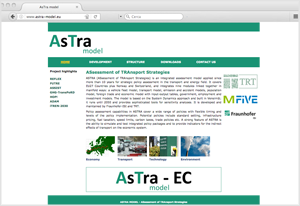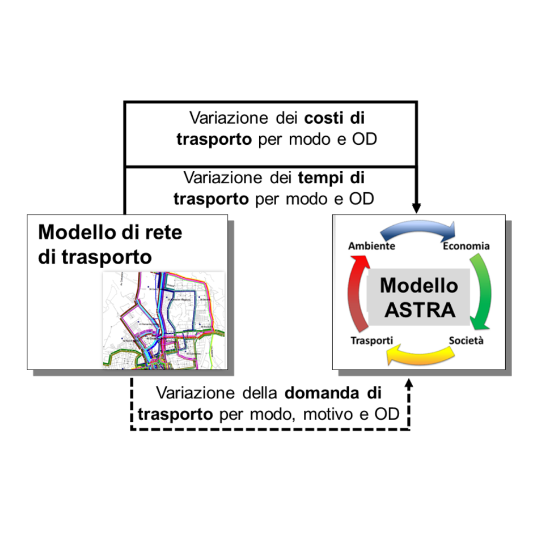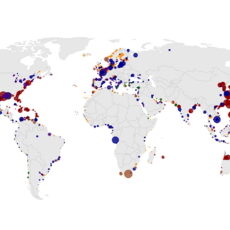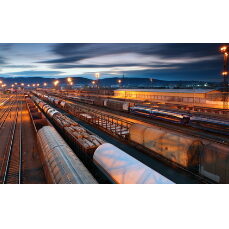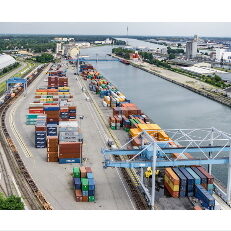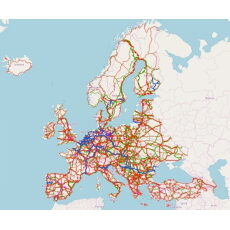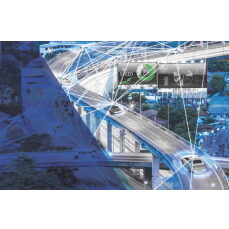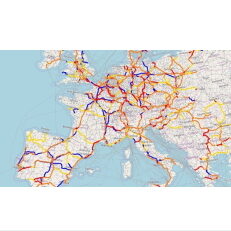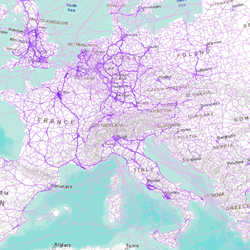
ASTRA (ASsessment of TRAnsport Strategies)
ASTRA (ASsessment of TRAnsport Strategies) is an integrated assessment model designed for strategic policy assessment of transport policies and investments up to the year 2050. Policy assessment capabilities in ASTRA cover a wide range of measures with flexible timing and levels of implementation. Potential policies include vehicle technologies, infrastructure development, pricing, taxation, speed limits, trade policies etc. A strong feature of the model is the ability to simulate integrated policy packages and to provide indicators for the indirect effects of transport policies and investments on the economy and the environment. Over time the application of the model has been extended from transport also towards economic impact assessment of climate policy and of renewable energy policy. For such analyses the ASTRA model has often been coupled to bottom-up techno-economic models.
General description
ASTRA is a strategic model based on the Systems Dynamics Modelling approach simulating the transport system development in combination with the economy and the environment until the year 2050. The ASTRA model is grounded on empirical data of its calibration period (which today is from 2000 until 2020). The model is made of different modules that interact among each other with direct and feed-back effects.
Strategic assessment capabilities in ASTRA cover a wide range of transport measures and investments with flexible timing and levels of implementation. Also when coupled with bottom-up models economic impact assessment of climate policy has been provided. Since many years the ASTRA model has been successfully used for the following applications:
- Transport policy assessment: pricing, taxation (on fuel or vehicle), emissions and efficiency standards, infrastructure investments
- Technology and scenario analysis: alternative vehicle technology (e.g. electric and fuel cell vehicles), integrated energy and transport policy (e.g. vehicle efficiency improvement)
- Renewable policy assessment: subsidies, feed-in tariffs, investment strategies
- Climate policy assessment and energy price trends
Geographically, ASTRA covers all EU 27 Member States plus United Kingdom, Norway and Switzerland. The model is built in Vensim software and is developed and maintained by TRT and M-Five (www.astra-model.eu).
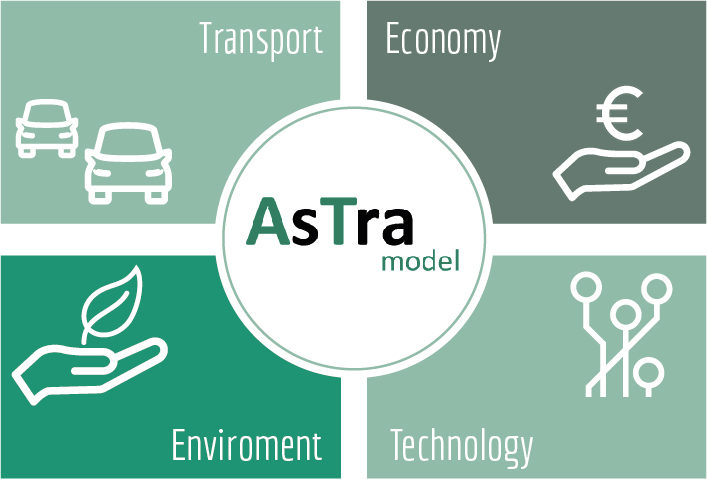
ASTRA structure and approach
ASTRA consists of different modules, each related to one specific aspect such as the economy, transport demand or the vehicle fleet. The main modules cover the following aspects:
- Population and social structure (age cohorts and income groups)
- Economy (e.g. GDP, input-output tables, employment, consumption and investment both at aggregate and at sectoral level)
- Foreign trade (inside EU and to partners from outside EU)
- Transport (including demand estimation, modal split, transport cost and infrastructure networks)
- Vehicle fleet (passenger and freight road vehicles by segment and drivetrain)
- Environment (including pollutant emissions, CO2 emissions, energy consumption).
The economy module simulates the fundamental economic variables. Some of these variables (e.g. GDP) are transferred to the transport generation module, which uses the input to generate a distributed transport demand. In the transport module, demand is split by mode of transport. The traffic performance by mode is associated with the composition of the fleet (computed in the vehicle fleet module) and the emissions factors (defined in the environmental module), in order to estimate total emissions.
Several feedback effects take place in the ASTRA model. For instance, the economy module provides the level of income to the fleet module, in order to estimate vehicle purchase. The economy module then receives information on the total number of purchased vehicles from the fleet module to account for this item of transport consumption and investment. Furthermore, changes in the economic system immediately feed into changes of the transport behaviour and alter origins, destinations and volumes of European transport flows.
The environment module uses input from the transport module (in terms of vehicle-kilometres-travelled per mode and geographical context) and from the vehicle fleet module (in terms of the technical composition of vehicle fleets), in order to compute fuel consumption, greenhouse gas emissions and air pollutant emissions from transport. ASTRA also estimates the upstream emissions (well-to-tank) due to fuel production and vehicles production. Therefore, well-to-wheel emissions can be provided as well.
ASTRA is calibrated to reproduce major indicators such as transport performance, fuel consumption, CO2 emissions and GDP according to the main European reference sources such as Eurostat and the EU Reference Scenario for future trends.
By simulating different policy bundles and framework conditions, ASTRA enables the comparison of different scenarios concerning, e.g., the diffusion of technologies, emission reductions, energy demand by energy carrier, required investments, etc.

Model input and parametrization
The model includes four main components: economy, transport, technology and environment.
The economy component consists of five elements: supply side, demand side (including an investment module), an input-output model based on 25 economic sectors, employment module and government module. In addition, two trade models are implemented (i.e. intra-EU trade and EU to rest-of-the-world trade) [3].
The transport component is represented by means of two classical 4-stage transport models, one for passenger and one for freight transport, including endogenous feedback on all stages. Even if a full origin-destination matrix is not modelled, demand is segmented according to trip purpose and in different distance bands to better consider the competition between alternative modes. The transport network is not explicitly represented but information on network capacity is considered in a simplified way for the different transport modes drawing on a network based transport model such as TRUST.
The technology component covers the differentiation of road vehicle fleets into drivetrain technologies, age classes and different emission standard categories. The technologies considered are listed below and cover gasoline, diesel, compressed natural gas (CNG), liquefied natural gas (LNG), liquefied petroleum gas (LPG), battery electric vehicles (BEV), plug-in hybrid electric vehicles (PHEV), fuel cell electric vehicles (FCEV) and trolleys for urban buses and long-distance trucks.
- Car: gasoline, diesel, CNG, LPG, BEV, PHEV, FCEV
- LDV: gasoline, diesel, CNG, LPG, BEV, PHEV, FCEV
- HDV: diesel, CNG, LNG, BEV, PHEV, FCEV, trolley
- Urban Buses: diesel, CNG, BEV, PHEV, FCEV
- Coaches: diesel, LNG, FCEV
Investments and learning curves are included in the simulation of the fleet development process. Road freight transport demand is segmented by different vehicle types:
light commercial vehicles (below 3.5 tonnes), medium heavy goods vehicles (from 3.5 to 12 tonnes) and large heavy goods vehicles (from 12 to 26 tonnes, from 26 to 32 tonnes and above 36 tonnes) – according to different spatial domains (i.e. local, short, national, international). Assumptions on the composition of vehicle fleet used in each spatial domain are made to reflect the use of each vehicle type. The demand for new heavy goods vehicles as well as the replaced vehicles is associated with emission standards depending on the year of registration, covering conventional diesel technologies as well as other technologies mentioned above. Efficiency improvements are also included for non-road modes.
The environment component calculates the air pollutant emissions and energy consumption from transport based on traffic flows, the information on the composition of the vehicle fleets and on emission / energy consumption factors. ASTRA quantifies the impacts on energy consumption by fuel, CO2 emissions and air pollutants (NOx, PM, CO and VOC), as well as transport accidents and the related externality value.
Model output
ASTRA assessment capabilities cover a wide range of policies with flexible timing and variable levels of the policy implementation. Potential policies include standards setting, infrastructure pricing, fuel taxation, speed limits, carbon taxes, investment in energy and transport infrastructure, trade policies etc. A strong feature of ASTRA is the ability to simulate and test integrated policy packages and to provide indicators for the indirect effects of transport on the economic system (e.g. sectoral value-added, sectoral employment, GDP, trade flows, income by income groups). ASTRA has also been applied to analyse future challenges, in particular the impact of high oil prices on the EU economy and the impact of ambitious European climate policy until 2050.
ASTRA model has been successfully used for the following applications:
- Transport policy assessment: pricing, taxation, TEN infrastructure, CO2-standards, Cost-benefit-analysis of transport projects;
- Technology and scenario analysis: technology and employment policy, hydrogen technology strategy, integrated energy and transport scenarios, energy and transport policy, impacts of connected and automated driving;
- Renewable policy assessment: subsidies, feed-in tariffs, investment strategies;
- Climate policy assessment: transport policy, EU-ETS, energy scenarios, decarbonisation strategies, investment strategies, cost implications.
The indicators that ASTRA can produce cover a wide range of impacts; in particular transport system operation, economy, environmental and social indicators.
More in detail, transport system operation indicators are estimated at aggregated level (namely at Country level); nevertheless, the additional value of using system dynamics for transport modelling enriches the analysis with respect to a traditional transport model, thanks to the linkage with the modules related to economic and technological aspects. The economic module of the ASTRA model addresses the linkages between transport and economy, mainly in terms of the effects of transport policy measures on regional GDP, consumption or sectoral employment; the fleet module reflects impacts on the technology side; the environmental module deals with health impacts of air-pollution. Furthermore, these additional impacts can interact with each other. As an example, let’s take the impact of road charging. If a charge is introduced or increased for cars in the transport module, this measure has a depressing effect on car purchasing. In turn, less cars mean that some less population has a private vehicle available and, since car availability promotes personal mobility, less trips will be generated. In another step forward, the impact of road charging on the vehicle fleet propagates itself until the economic model, where less consumption and investment are modelled and therefore lower GDP, less employment and less production. The reduction of economic activity is fed back into the demand estimation, because freight transport demand depends on production and because employed people travel more than unemployed people.
However, since endogenous productivity impacts are considered in the ASTRA economy model, the economic impulses of a policy may generate different impacts than in general equilibrium models primarily considering price effects.
In general, the variety of indicators estimated with the ASTRA model and the fact that these indicators are provided as time series offer the opportunity to apply a large variety of different assessment schemes to support the development of European energy, transport and climate policies. As an example, the following indicators can be provided by the ASTRA model:
- Passenger trips by mode
- Freight tonnes transported by mode
- Passenger-km travelled by mode
- Tonne-km travelled by mode
- Air pollutant emissions
- Energy consumption of transport sector
- GHG emissions of transport sector
- Transport Accidents
- Externalities of transport sector
- Transport expenditure
- Road vehicle fleet composition by technology
- GDP
- Employment total and sectoral
- Consumption total and sectoral
- Investment total and sectoral
- Sectoral gross value-added
- Sectoral trade flows.
ASTRA application
Since its first developments ASTRA has been successfully used in several studies on behalf of European Commission and other European institutions
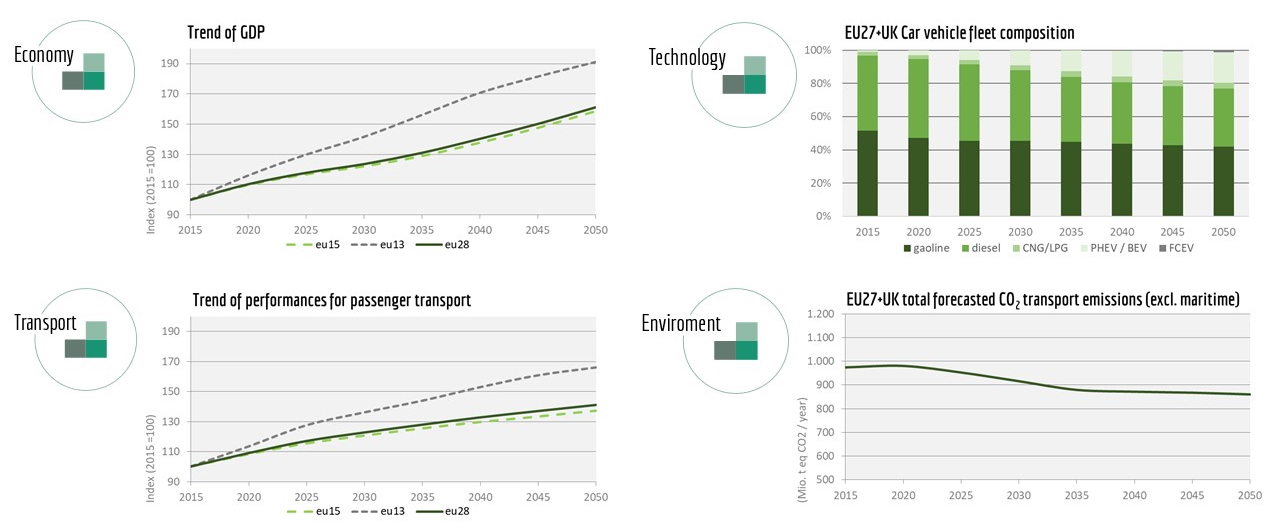
- ASTRA-ЕС model update and improved interaction with multimodal network assignment tools ASTRA is an integrated strategic model employed for policy assessment in the transport and energy field. The model is based on the System Dynamics approach and built in Vensim; it simulates the interaction between the transportation system and the environmental and economy modules. It is developed by TRT and used for several years by the Joint Research Center of the European Commission. TRT supported the use of ASTRA by JRC in two studies: http://www.astra-model.eu/
- Study on cross-border investment needs and climate adaptation of the TEN-T network The effective implementation of the TEN-T policy, with the completion of the core network and the extended network by 2030 and 2040, is key to creating a competitive industry, expanding the labour market, promoting growth and jobs and improve the daily lives of European citizens. It is therefore important to ensure sufficient investment for the completion of the TEN-T network. While it is important to complete the TEN-T, it is equally important to ensure that the infrastructure resists the threats of extreme events resulting from climate change, which will continue to increase in frequency, intensity, duration and spatial extent in the coming decades. The objectives of this study are: 1) identify the investments necessary to make the TEN-T resilient to climate change, 2) identify the investments necessary to remove the cross-border bottlenecks of the TEN-T and ensure its completion. In the study conducted together with M-FIVE (DE), VUB (BE) and ISL (DE), TRT is responsible for: Analyse and quantify the investments necessary for the completion of the TEN-T network until 2040, with particular focus on 43 cross-border projects and 33 national projects. Carry out an assessment of the economic and transport impacts resulting from the non-completion of cross-border projects with the support of two European-scale models TRUST and ASTRA. Analyse the role of CEF (Connecting Europe Facility) funds as a stimulus to the implementation of cross-border projects.
- Impact assessment on measures to better manage and coordinate international rail traffic, including through revised rules for capacity allocation and infrastructure charging in rail The impact assessment study is intended to provide evidence-based support for developing a new initiative implementing: Action 19: Measures to better manage and coordinate international rail traffic, including – if necessary – through revised rules for capacity allocation and infrastructure charging in rail Action 24: EU 2021 Rail Corridor Initiative – Revise the Rail Freight Corridor Regulation of the European Commission’s Smart Mobility Strategy (COM/2020/789 final) for achieving the objectives of the EU Green Deal (COM/2019/640 final). In the Green Deal and the Strategy vision for the future EU transport system, a substantial part of the 75% of inland freight carried today by road should shift onto rail and inland waterways. Moreover, rail freight traffic is projected to increase by 50% by 2030 and double by 2050; by 2030, rail and waterborne-based intermodal transport will be able to compete on equal footing with road-only transport in the EU.
- Impact assessment support study for the new proposal addressing the development of multimodal digital mobility services and a cost-benefit analysis for the revision of Delegated Regulation (EU) 2017/1926 on multimodal travel information services Maximising multimodality and intermodality in passenger mobility is a key element in reducing transport’s contribution to climate change while ensuring that transport systems operate efficiently, both within Member States and also across the EU’s internal borders. Multimodal digital mobility services (MDMS) are, in turn, crucial to foster multimodality as they promote comparability, transparency, and the selling of products across operators and modes. MDMS bring direct benefits to users: they help people to navigate and access an increasingly complex and diverse range of transport offerings, including a range of shared mobility services, as well as to understand the role and benefits of active modes, that will help them meet their mobility needs in different, more sustainable ways. This can also help to increase accessibility more generally, and so help to reduce social exclusion, by enabling those most in need to access the mobility services that enable them to participate more fully in society. Services that support multimodal transport also help to make transport more efficient and sustainable by increasing the utilisation of the various transport services, improving their operation, and nudging users towards the more sustainable options. The study is crucial in informing the scope and focus of the actions that are necessary at the EU level to ensure that MDMS can fully contribute to the aims of the Smart Mobility Strategy and the Green Deal and, more importantly, bring their associated benefits to users and the environment.
- Analysis accompanying the Impact Assessment for the revision of Directive 92/106/EEC (Combined Transport Directive) The project aims to provide a robust evidence-based analysis to develop an impact assessment on the possible revision of the Combined Transport Directive. The objective of the revision is to increase the share of rail, SSS and IWW in the EU freight transport, reducing GHG emissions as well as other transport externalities such as congestion and accidents. The impact assessment should inform the specific measures to be included and the level of ambition of the revised Directive, including the following tasks: Task 1: analysis of the main problems and policy objectives identified by the Commission Task 2: Assessment of the policy measures according to their legal, political and technical feasibility Task 3: Analysis of the baseline scenario, including both the status-quo and the likely evolution of the problem drivers Task 4: Assessment of the economic, social and environmental impacts of each policy option Task 5 and 6: comparison of options and selection of the preferred policy options TRT is involved mainly in Task 3 and 4, providing among others EU scale modelling (ASTRA) for estimations of key variables (transport activity, modal share, fuel consumption, emissions, etc.) for the baseline and policy scenarios, and tailored cost models to quantify the economic impacts of the proposed measures and combination of measures.
- Impact assessment for the revision of regulation (eu) n° 1315/2013 on union guide-lines for the development of the trans-european transport network The European Union with the Green Deal (proposal EC COM(2019) 640 final) has agreed to implement the Paris Climate Agreement leading the EU towards climate neutrality in 2050. In a more detailed communication in 2020 the European Commission proposed to step-up the climate policy ambition for 2030 and reduce GHG emissions of the EU by 55% compared to 1990 (EC COM(2020) 562). For the transport sector the EC published a new smart and sustainable mobility strategy in December 2020 (EC COM(2020) 789) presenting the strategic policy framework that would deliver the GHG reductions required by the transport sector for 2030 and until 2050. As part of this highly dynamic policy framework the EC has foreseen the revision of several existing transport regulations. The revision of the TEN-T guidelines is one of the major transport related policies besides the revision of the Alternative Fuels Infrastructure and the Intelligent Transport System directives and the planned revision of the Rail Freight Corridors regulation. This study carries out the analysis accompanying the impact assessment for the revision of Regulation (EU) N° 1315/2013 on Union Guidelines for the development of the trans-European transport network. Supported by two European scale modelling tools ASTRA and TRUST, the study provides the assessment of three alternative policy options in terms of their transport, economic, social and environmental impacts and identifies the most promising one. The report is available on the website of the “Publications Office of the European Union” at this link.
- Study on exploring the possible employment implications of connected and automated driving The European Commission has commissioned a study focused on getting a better understanding of the impacts on work and employment in the transport sector resulting from the introduction of vehicles with connected and autonomous driving (CAD). The study is aimed at supporting the development of adequate policies to promptly mitigate any negative impacts. Part of a consortium led by Ecorys (NL) and participated by M-Five (DE), VTT (FI), SEURECO (FR), ERTICO, IRU and UITP, TRT is in charge of the design and development of 4 explorative scenarios that consider different levels of penetration of CAD vehicles for the evaluation of the consequent employment repercussions. The evaluation of the impacts is supported by two modelling tools on a European scale ASTRA and NEMESIS. Scenarios’ creation is supported by the Scenario Model. Developed by TRT in System Dynamics, the Scenario Model considers the main drivers on both the supply and demand sides, which influence the uptake of autonomous driving vehicles. The elements on the supply side concern the technology and the conditions of use of CAD; the elements on the demand side concern requirements, preferences and constraints that guide the choice of modes and means of transport. In addition to supply and demand, a third important aspect considered by the model is the regulation introduced by authorities concerning the use of CAD vehicles in different environments. For more information: The Main Report and its annexes are available for download; A brochure of the report is available too; The findings were also presented during a conference in September 2020, where stakeholders in road transport discussed a potential social roadmap for automation.
- The Impact Assessment study, developed for the European Commission, aims to identify and assess the impacts of policy measures on facilitating the deployment of multimodal ITS services By enabling communication between vehicles, infrastructure and other road users, Cooperative Intelligent Transport Systems (C-ITS) can greatly improve safety and efficiency in road transport. Here is a look at some of the most recent developments in C-ITS and how quickly the technology could change the way we drive and interact with each other in traffic. The wide-scale deployment of Cooperative Intelligent Transport Systems could contribute to delivering several Commission’s objectives for transport, such as those on safety, reduced congestion, enhanced mobility and environmental performance. Together with Ricardo Energy&Environment, TRT supported the Directorate for Mobility and Transport of the European Commission in three different studies over a six year period. In 2020-2021 for the development of an Impact Assessment Support Study for the revision of the Intelligent Transport Systems Directive (2010/40/EU) to support the EC with evidence-based analysis. In 2017-2018 developing the legal framework required to support the widespread deployment of C-ITS services in Europe by 2019: a set of policy options and deployment scenarios were assessed with the European scale modelling tools ASTRA and TRUST for the analysis and comparison of the impacts in terms of economic, environmental and social indicators. In 2015 for the preparation of the Communication strategy and the Action plan for the deployment of C-ITS in Europe, providing the analysis of costs and potential benefits based on different scenarios. To support the analysis, the ASTRA and TRUST models are applied to provide quantitative indicators to evaluate the impacts of various policy options and deployment scenarios. For more information Final report of 2015 study Final report of 2017-2018 study
- The impact of TEN-T completion on growth, jobs and the environment The objective of the study is to quantify the impact of the TEN-T core network implementation until 2030 – as well as the impact of each of the nine core network corridors separately – on European Union growth, jobs and the environment. The assessment is done with the support of two European scale modelling tools ASTRA and TRUST. ASTRA is a System Dynamics model used for assessing the wider economic impacts like indirect and induced changes in employment or value added and economic growth due to the TEN-T investments. TRUST is a transport network model allowing for the assignment of OD matrices at the NUTS3 level for passenger and freight demand which is used to provide the transport quantitative inputs to ASTRA. A set of major economic, environmental and transport indicators is provided for the assessment at EU level as well as at the level of Member States for the base year 2015 and the time horizons 2020, 2025 and 2030. The quantitative indicators are accompanied by qualitative arguments where required to elaborate on the quality of jobs created and the typology of jobs. For more information The impact of TEN-T completion on growth, jobs and the environment. Go to the publication
- Impact assessment accompanying the revision of Eurovignette Directive for Heavy Goods Vehicles charging The “Eurovignette” Directive provides a detailed legal framework for charging heavy goods vehicles (HGVs) for the use of certain roads. Following ex-post evaluations of the current legislative framework, the Commission intends to assess the potential impacts of options for a possible revision of the legislative act. The impact assessment study will help substantiate the specific problems linked to charging of vehicles and to design policy options in this field. TRT supports the quantitatve assessment of the impacts of the policy options through the use of European scale models ASTRA and TRUST.
Contacts
For more information on the ASTRA model and its potential applications please contact the experts of TRT Trasporti e Territorio
ASTRA model website
